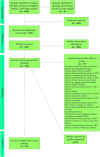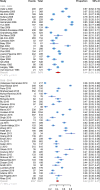Prevalence and genotype distribution of genital human papillomavirus infection in female sex workers in the world: a systematic review and meta-analysis
- PMID: 32977797
- PMCID: PMC7519561
- DOI: 10.1186/s12889-020-09570-z
Prevalence and genotype distribution of genital human papillomavirus infection in female sex workers in the world: a systematic review and meta-analysis
Abstract
Background: Female sex workers (FSWs) are amongst the most susceptible groups to acquire human papillomavirus (HPV) infection and consequently, to develop cervical intraepithelial neoplasia and cervical cancer. This is the first systematic review and meta-analysis to provide estimates of the pooled prevalence of HPV infection and the distribution of HPV types among FSWs across the world.
Methods: Five computerized databases were searched for relevant studies published since the inception date of databases to September 2019. The pooled HPV prevalence was calculated by the random effect model described by DerSimonian-Laird. Subgroup analysis was performed to identify the probable sources of heterogeneity. The meta-analysis was performed using the "Metaprop" function in the R package Meta.
Results: Sixty-two studies involving 21,402 FSWs from 33 countries were included in this meta-analysis, and the pooled HPV prevalence was 42.6% (95% confidence interval (CI): 38.5-46.7%). HPV-16 (10.1, 95% CI: 8.2-12.5%), HPV-52 (7.9, 95% CI: 5.9-10.7%), and HPV-53 (6.0, 95% CI: 4.4-8.1%) were the most common high-risk HPV types identified among FSWs. The pooled estimated prevalence of HPV infection among FSWs before and after 2010 were slightly different, 43.6% (95% CI: 36.1-51.4%) and 41.9% (95% CI: 37.2-46.8%), respectively.
Conclusion: Due to the high prevalence of HPV infection, particularly with high-risk types, FSWs have a great susceptibility to the development of cervical and vaginal cancers. Furthermore, they can transmit their infection to their clients, which may result in a high prevalence of HPV and the incidence of HPV-associated malignancies among the general population.
Keywords: Epidemiology; Female sex workers; HPV; Human papillomavirus; Meta-analysis; Prostitution.
Conflict of interest statement
The authors have no conflict of interest.
Figures




Similar articles
-
Worldwide burden of genital human papillomavirus infection in female sex workers: a systematic review and meta-analysis.Int J Epidemiol. 2021 May 17;50(2):527-537. doi: 10.1093/ije/dyaa289. Int J Epidemiol. 2021. PMID: 33517415
-
Human papillomavirus infections among Hungarian female sex workers.Eur J Cancer Care (Engl). 2014 Jan;23(1):65-75. doi: 10.1111/ecc.12110. Epub 2013 Aug 19. Eur J Cancer Care (Engl). 2014. PMID: 23957436
-
Human papillomavirus infection and cervical dysplasia in female sex workers in Northeast China: an observational study.BMC Public Health. 2015 Jul 23;15:695. doi: 10.1186/s12889-015-2066-x. BMC Public Health. 2015. PMID: 26202513 Free PMC article.
-
Associations Between Vaginal Infections and Potential High-risk and High-risk Human Papillomavirus Genotypes in Female Sex Workers in Western Kenya.Clin Ther. 2016 Dec;38(12):2567-2577. doi: 10.1016/j.clinthera.2016.10.005. Epub 2016 Nov 9. Clin Ther. 2016. PMID: 27836494
-
Molecular epidemiology of human papillomavirus among HIV infected women in developing countries: systematic review and meta-analysis.Virol J. 2020 Nov 16;17(1):179. doi: 10.1186/s12985-020-01448-1. Virol J. 2020. PMID: 33198743 Free PMC article.
Cited by
-
Prevalence of sexually transmitted infections and human papillomavirus in cervical samples from incarcerated women in São Paulo, Brazil: a retrospective single-center study.Front Public Health. 2024 Jul 23;12:1353845. doi: 10.3389/fpubh.2024.1353845. eCollection 2024. Front Public Health. 2024. PMID: 39109153 Free PMC article.
-
Generating human papillomavirus (HPV) reference databases to maximize genomic mapping.Arch Virol. 2022 Jan;167(1):57-65. doi: 10.1007/s00705-021-05256-y. Epub 2021 Oct 19. Arch Virol. 2022. PMID: 34668074
-
Attitudes towards sex workers: a nationwide cross-sectional survey among German healthcare providers.Front Public Health. 2023 Sep 6;11:1228316. doi: 10.3389/fpubh.2023.1228316. eCollection 2023. Front Public Health. 2023. PMID: 37744482 Free PMC article.
-
Women's experiences and acceptability of self-administered, home delivered, intravaginal 5-Fluorouracil cream for cervical precancer treatment in Kenya.medRxiv [Preprint]. 2025 Jan 2:2024.08.27.24312651. doi: 10.1101/2024.08.27.24312651. medRxiv. 2025. Update in: Front Reprod Health. 2025 Feb 06;7:1487264. doi: 10.3389/frph.2025.1487264. PMID: 39568790 Free PMC article. Updated. Preprint.
-
Barriers to HPV vaccine series completion among a predominantly hispanic border population: a mixed method evaluation.Arch Public Health. 2024 Jul 24;82(1):112. doi: 10.1186/s13690-024-01344-y. Arch Public Health. 2024. PMID: 39049107 Free PMC article.
References
-
- Schmitt M, Depuydt C, Benoy I, Bogers J, Antoine J, Arbyn M, et al. Prevalence and viral load of 51 genital human papillomavirus types and three subtypes. Int J Cancer. 2013;132(10):2395–2403. - PubMed
Publication types
MeSH terms
LinkOut - more resources
Full Text Sources

